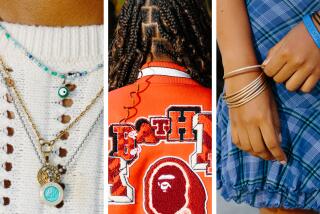FASHION : How to Dress for Success--Let Us Count the Ways : A survey generally finds that workers seem to be attired conservatively. One bank prescribes a uniform of sorts.
The word corporate in describing manner of dress no longer wears a neat, buttondown definition.
That is certainly true in Ventura County.
How do locals dress for success? Do Fortune 500 companies still require a suit and tie? Are there equal standards for women? How are highly individualistic Californians guided in fashion matters? Does anyone show (blush) poor taste?
We checked.
We found that some Fortune 500 companies seemed uneasy talking about what their employees wear to work, a subject they had clearly never addressed publicly. We also found that the countywide power dressing quotient is: low-key.
Poor taste? Well, it’s like that upscale plumbing sculpture at the Ventura Pier--a matter of opinion.
We asked a couple of public agency employees if they had ever observed any tasteless apparel on-site. A personnel administrator from the County Government Center kept it theoretical. Potentially, tank tops and shorts for employees would be unacceptable, he said. But inappropriate dress never comes to the attention of the personnel office; such matters are discreetly handled at the department level.
A Planning Department employee at Ventura City Hall said that almost invariably, men conform to collars and ties and women to dresses. Suit coats are almost unknown, except among city attorneys. In her opinion: “It’s pretty boring. It’s like (the women) went to a department store and went into the business dress section.
“The stylish people wear vests,” she said, estimating that about 10% of the ranks at City Hall fall into that category.
Among private employers, one complained that workers were too conservative. Chuck Pelly, CEO of Designworks in Westlake Village, where the BMW’s electric car project is under way, said industrial designers dress too traditionally.
“Our request to the designers is to wear brighter, wilder outfits,” he said wistfully. “We’d like them to look more California.”
Of the Fortune 500, Xerox Corp. was the most reserved about discussing style of dress. We were referred to headquarters in Connecticut, where officials, understandably, said they had no idea what employees in Thousand Oaks wear.
At the county’s largest employer, GTE, we learned that management cleaves to coat and tie. Staff members may remove ties on Fridays if their department head approves. The guideline for women’s attire is covered by the phrase “neat and appropriate.”
“We don’t see the wild and the bizarre here,” a company spokesman said.
At Proctor & Gamble in Oxnard, those who wear ties any day of the week are considered snobs, said Bob Paulger, director of industrial relations. He confessed that when he has an off-site meeting, he keeps a coat and tie in the trunk of his car just to be prepared.
Elsewhere, open-collar, dress-down Fridays seem to be hot, with a few reported conflicts with staff about just how casual “dress down” is meant to be.
At Pepsi-Cola, jeans and sneakers are not welcome on Friday, although a long top with tights for a woman might get by. At Kinko’s, T-shirts can pass, but “we would probably prefer a shirt with a collar,” said Dick Summers, director of human resources.
“We want them to be a little bit independent and express themselves as long as it doesn’t get out of hand,” he said.
“Out of hand” is probably best portrayed by employees at Patagonia in Ventura.
This sportswear company has about 200 of what would otherwise be considered white-collar workers. But white collars are scarcer here than fur at a Greens rally.
An informal tone was set by Patagonia’s receptionist, who, on learning the subject of inquiry, said: “I am really overdressed. I’m wearing shoes.”
Yes, bare feet are common, as are wild and funny T-shirts, tank tops, shorts, high tops and flip-flops.
“If someone feels more comfortable wearing a jacket and tie, they are perfectly welcome (to),” Lu Setnicka of the company’s human relations office said.
Asked if anyone ever did, she paused. “If they are in a jacket and tie, they are looking for a job,” she said. “We let them know in advance the atmosphere is quite causal; (formal dress) does draw attention.”
We recalled the Ventura attorneys, and asked what the Patagonia counsel wears. “He wears jeans and a Patagonia shirt,” was the response.
Patagonia has one restriction on dress: no slogans on clothing that might offend other workers. Also, store personnel are constrained to wear shoes and to shun “baggy” shorts.
At the other end of the spectrum is the Bank of A. Levy. There, to ensure that the attire of employees who deal with the public is always professional, the company provides the wardrobe: conservative skirts, jackets and blouses for women, solid or pin-striped suits for men. Women wear red, navy, camel, blue or gray. Men stick to gray or navy, with solid color ties and shirts; color-coordinated socks are furnished for them.
“A lot of people who come to work here think of it as a benefit,” said Clare Ellinger, the bank’s vice president of human resources.
Indeed, some employees who don’t meet the public purchase the official wardrobe anyway.
At the bank’s headquarters, women employees are asked to wear hosiery at all times, and all workers are to avoid denim, corduroy and “separates that are not part of a coordinated outfit.”
Casual days do occur at Levy, but they would fall, Ellinger said, “probably once a year.’
“That would be kind of a treat,” she added.
Holidays can be their own thing, however. At Levy’s Port Hueneme branch, tellers dressed up for Halloween, manager Kim Gibas said. But even this was formalized. They all wore green eyeshades, white shirts with banded sleeves and black trousers. A few had fake mustaches.
It was a great opportunity to kick up a few heels.






